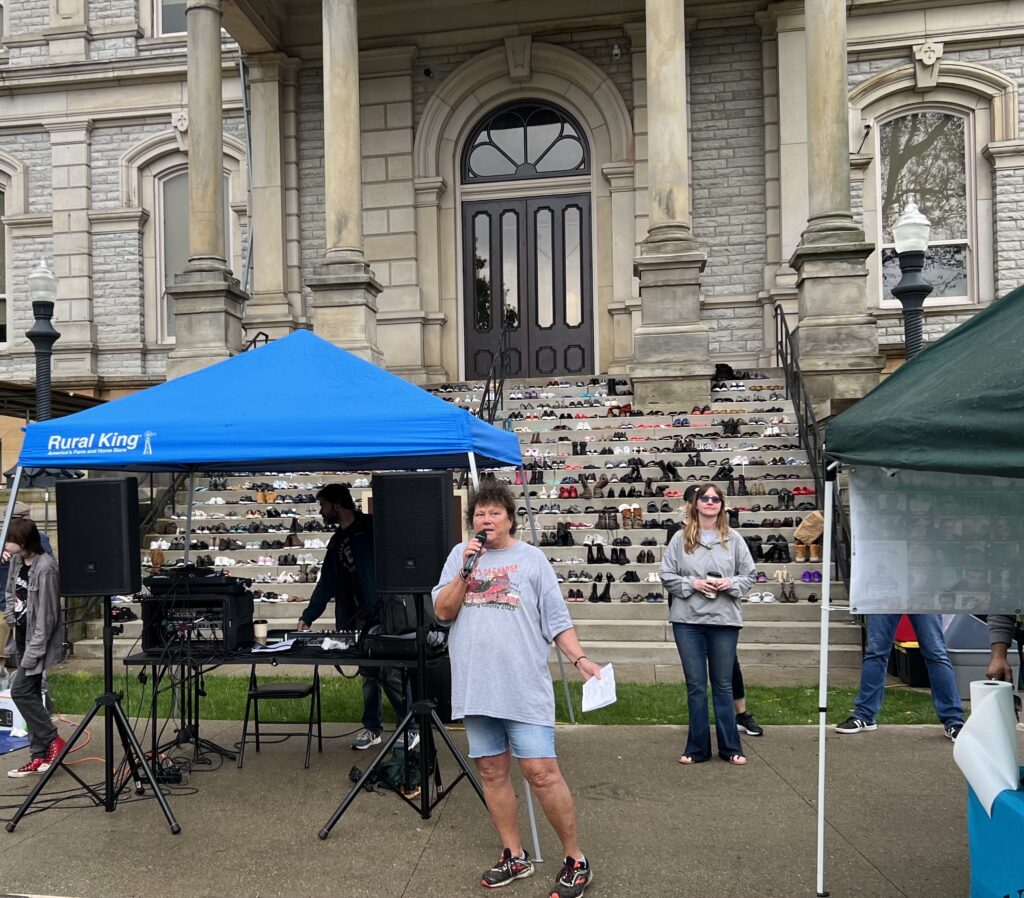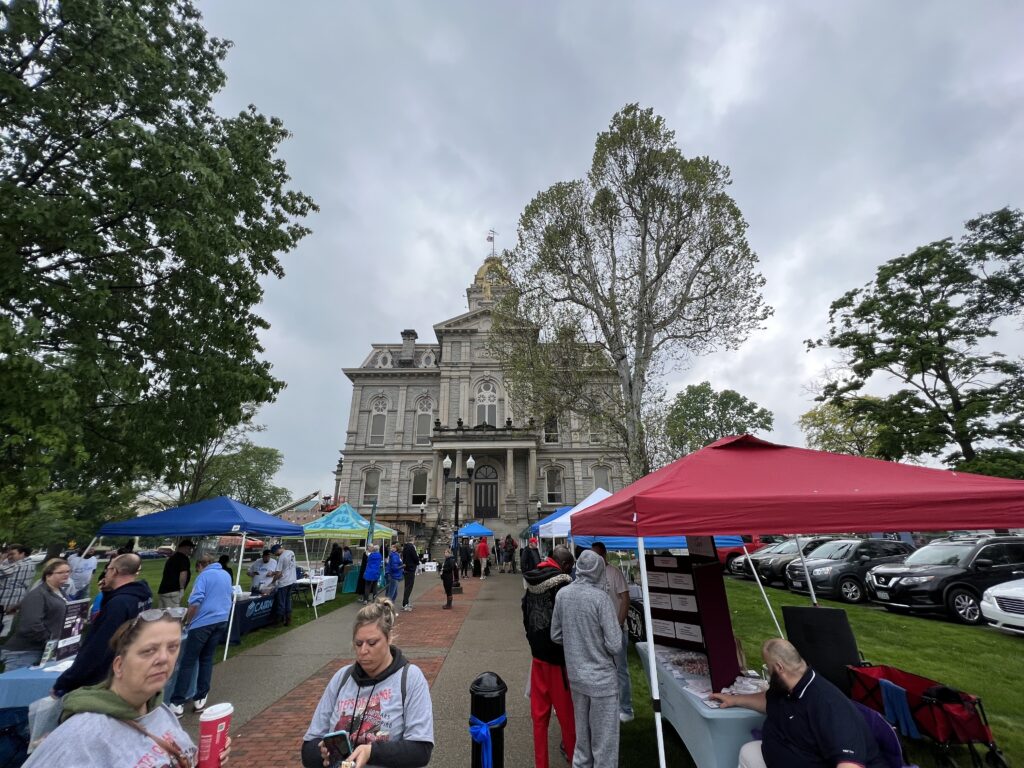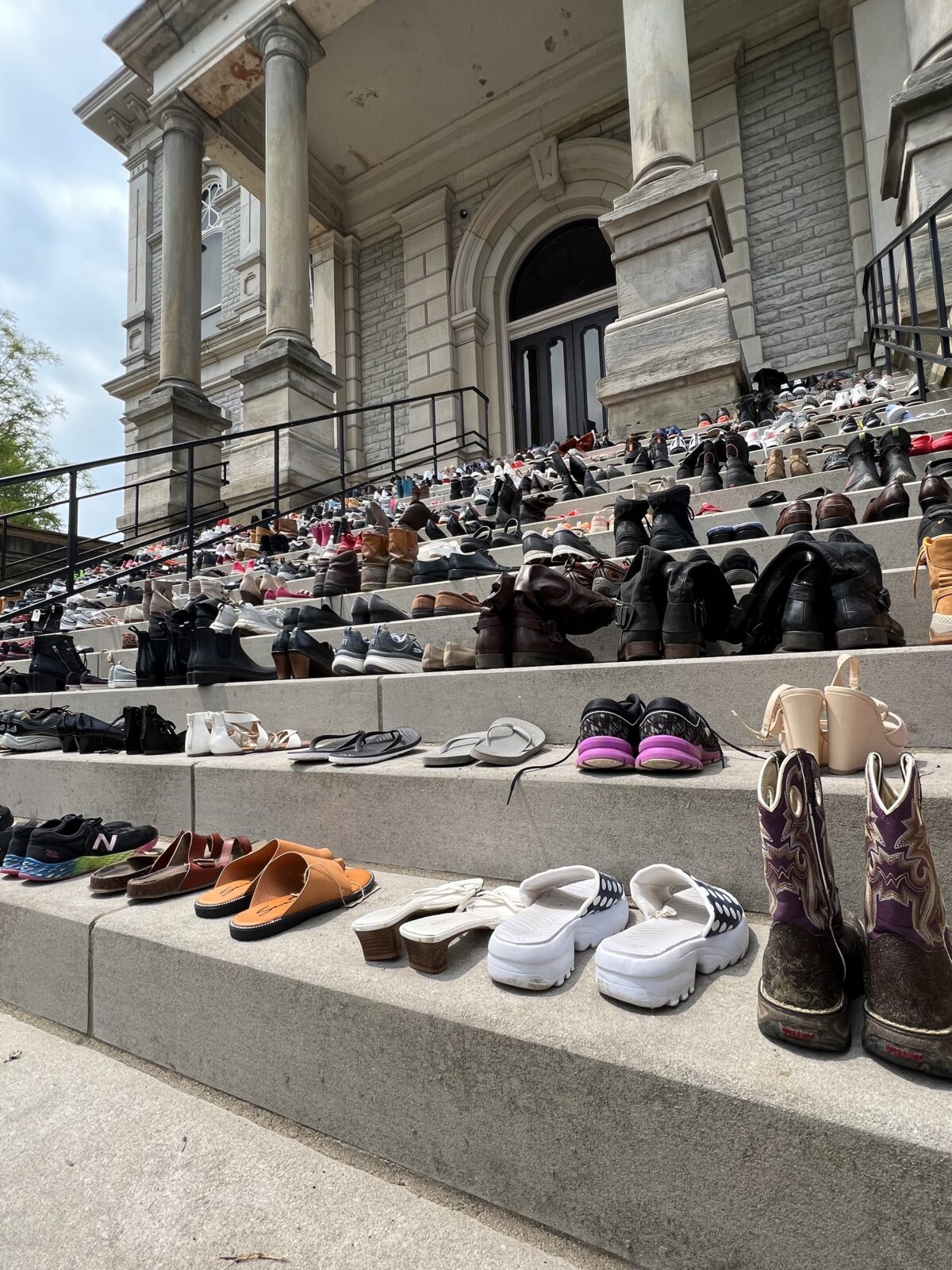Smiles and giggles filled the air as volunteers painted the faces of preschoolers. It was a fun day out for families who struggle with the daily challenges of keeping a roof over their heads and food on the table.
These families were among the nearly 200 people who gathered last month at the Licking County Courthouse this spring during the fifth annual Steps of Change, “Walk a Mile in My Shoes,” event. It was organized by the Newark Homeless Outreach and Ohio CAN (Change Addiction Now).

Concerns about housing insecurity have been mounting in recent years in Licking County, and the arrival of the Intel computer chip factory 15 miles west of downtown Newark has heightened those concerns, because the company will bring thousands of workers to an already tight housing market in central Ohio. Pressure on the housing market has pushed purchase and rent prices beyond reach for a growing number of low-income families.
A recent report by the United Way of Licking County shows that a growing number of working, low-income families are one flat tire or health-care bill away from financial disaster.
The report called ALICE – which stands for Asset Limited, Income Constrained, and Employed – represents the households that struggle to meet essential expenses such as food, health care, housing, transportation, and child care due to insufficient income.
The ALICE households are just above the poverty line, which means that one unforeseen crisis could result in dire financial distress. The report shows that more than 10% of households in Licking County fall below the poverty line, with an additional 27% classified as ALICE households.
Some in Licking County live below both the ALICE and poverty thresholds.
See related story: Motel evacuation leaves Licking County residents unhoused, shows effects of tight housing market and overwhelms support systems
Deb Tegtmeyer, Executive Director of the Licking County Coalition for Housing, said that as of June 13, there are approximately 100 unsheltered adults and 64 others in temporary shelter housing. These numbers do not include children, she said.
In Columbus, the Community Shelter Board reported in June that it had counted 2,337 people designated as unhoused during an annual survey done in January.
And in another measure of the growing number of people living on the edge, The Columbus Dispatch reported in June that “the Mid-Ohio Food Collective is seeing an ‘unprecedented’ need and record demand across its 680 partner sites in 20 area counties, officials say, with a 40% increase in visits since the same time last year.
People received food assistance 680,995 times at those sites from Jan. 1 to May 31, according to the nonprofit food distributor, up from 484,400 visits during the same period in 2022.

The May 20 Steps of Change event on Newark’s Courthouse Square showed the precarious financial position of so many families in Licking County while also highlighting the many organizations working to help families find solutions.
Fifteen local assistance organizations lined the Courthouse sidewalks with tents and representatives giving out information about their programs for mental health, addiction, recovery and relief for those who are unsheltered.
The centerpiece of the occasion was a memorial to those who had died as a result of complications related to homelessness, substance use disorder or mental illness. The remembrance featured about 450 pairs of shoes across all 17 steps at the east entrance to the courthouse. Each pair of shoes honored an individual.
“It’s a beautiful thing, yet at the same time, tragic,” said Ben Shirley, Homeless Outreach Specialist at Behavioral Healthcare Partners of Central Ohio. “The growing number of shoes serves as a reminder that people are still dying out here and that this problem simply hasn’t gone away”
Patricia Perry, founder of the Newark Homeless Outreach program, agreed with Shirley.
“Unfortunately, the amount of shoes is growing,” she said. “The number of overdoses and the number of homeless in Licking County is rising quickly, too. Regardless of whether we see or hear about them, this is still a huge problem.”
The United Way report illustrates that problem. In just two years, the number of households living on the edge grew by 14%, with 3,159 households being added to this demographic between the years 2019 and 2021.
Deb Dingus, Executive Director of the United Way of Licking County, said that federal financial aid that came during the COVID-19 pandemic is ending, so the number of households in financial distress is expected to rise in the near future.
“We’re starting to see folks who were already fragile during the pandemic become even more fragile as these support systems begin to disappear.” Dingus said.
Between the start of the pandemic in 2019 and the end of 2021, the ALICE estimated “survival budget” increased by 13%, from $56,281 to $63,684. The survival budget reflects the minimum cost to live and work in the modern economy and includes housing, child care, food, transportation, health care, a smartphone plan, and taxes.
Members of the Newark Think Tank on Poverty said that the tightening housing market in central Ohio has resulted in a rapid increase in housing costs, especially for renters.
Last October, The Think Tank conducted a survey in two distressed neighborhoods near downtown Newark. The survey showed that 27% of respondents think that the new Intel factory will increase their financial distress.
According to Rocket Homes, the median selling price for a home has increased by 8% across the Licking County market in the past year.
The Columbus Dispatch reported in February that Granville led central Ohio with a 28% gain in median sales price in 2022. “Next were Powell, in Delaware County, up 23%; Johnstown, in Licking County, up 21%, and New Albany, a portion of which is where Intel will be located in Licking County, up 20%. Close behind were the Licking County communities of Pataskala, with an 18% jump, and Newark, with a 14% gain.”
“It’s hard to keep up,” one unsheltered resident said during the Steps of Change event. “It’s hard to pay rent if you don’t have a job, and it’s hard to find work if you don’t have an address, a clean pair of clothes and, hell, some of us don’t even have phones.”
This daunting spiral is common among unhoused people and is only complicated by the physical and mental health needs some of them face.
James “Jaz” Robinson, who recently found a place to stay in Newark, spoke about how his health has inhibited his job search.
“Right now, I’m strung up with PTSD and an ongoing heart condition,” he said. “To get a job, I’ve got to get back on my feet and get my health back. There’s a lot of us out here like that.”
Mental illness affects some of those without housing in Licking County. While some are born with them, others acquire them as a result of trauma, such as domestic or sexual abuse.
“That’s why a lot of people out here turn to drugs,” said Suzy Wilson, a guest at the Newark Homeless Outreach, “It works for a bit, but then it brings its own bag of issues.”
One of these issues is losing their homes.
And even if one manages to find work, many low-paying jobs don’t provide enough to support living in Licking County. This year’s Out of Reach Report conducted by the National Low Income Housing Coalition, said that to afford a two-bedroom apartment in Licking County, renters must make at least $22.37 an hour.
Jobs with limited experience and education requirements tend to float at or close to the state minimum wage, which currently is $10.10. Therefore, even two incomes at or near minimum wage would leave a worker struggling to afford an apartment in Licking County.
“These issues that we’re out here supporting today aren’t going away,” Perry said during the downtown Newark event in May. “Our battle against this is just beginning, and look at the support we’ve already received.”
A stark reminder of the need – and the worst possible outcome of living in poverty – was visible in the 450 pairs of empty shoes on the courthouse steps.
Jack Wolf writes for TheReportingProject.org, the nonprofit news organization of the Denison University Journalism Program, which is sponsored in part by the Mellon Foundation.

